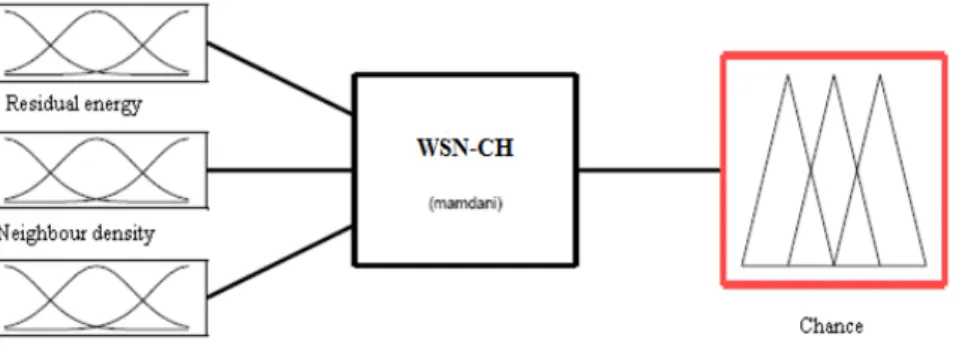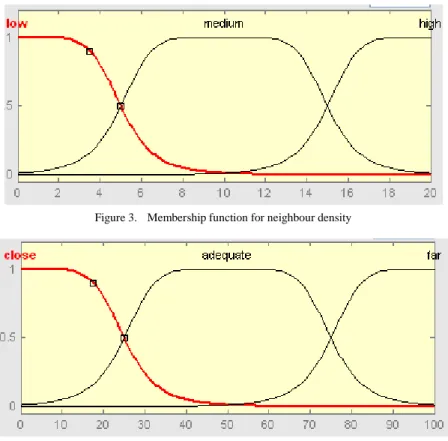Fuzzy Logic Controlled Cluster Head
Selection for Wireless Sensor Networks
Partha Pratim Bhattacharya
1,
Anita Garhwal
2 1 2 Department of Electronics and Communication Engineering,1 Faculty of Engineering and Technology,
Mody Institute of Technology & Science (Deemed University), Rajasthan, Pin-332311, India. 2 Sobhasaria Group of Institutions, Rajasthan, Pin-332311, India.
1 hereispartha@gmail.com; 2 anitagarhwal@gmail.com
Abstract- In Wireless Sensor Networks (WSN), cluster based methods are well known with special advantage of scalability and efficient communication. In this case, the entire network is divided into clusters and in each cluster a cluster head node is selected, normally based on maximum residual energy. But there are other parameters which must be considered for electing cluster head for prolonged lifetime. In this paper, a fuzzy logic based cluster head election method is proposed which considers three determining parameters for cluster head selection. The model is simulated and the response is studied.
Keywords – Wireless sensor network, Fuzzy logic, Cluster head, Cluster head selection I.INTRODUCTION
A wireless sensor network consists of a large number of sensor nodes which perform sensing and computation. The sensor nodes collect the information such as humidity, pressure, temperature etc. and pass to the base station. Wireless sensor network (WSN) finds applications in processing, information gathering in harsh weather and climate monitoring, radio transmission–reception, sensing and actuating [1].
Due to recent progress in technology, there is a growth in wireless sensor network which comprises of large figure of homogeneous and heterogeneous sensor nodes which communicate in wireless fashion to achieve common objective. Homogeneous nodes are preferred over heterogeneous nodes because of less complexity and better manageability. Each sensor node communicates with other nodes within its radio communication range.
Wireless sensor network consist of about thousands of motes for exchange of information using external base station (BS) or user directly. Data from the environment surrounding are sensed by sensor nodes and through the external base station data is sent to the outside world. Base stations have the capability of connecting the sensor network to an internet or to an existing communication infrastructure using a mobile node or a fixed node [2].
Two major tasks which an ordinary node performs are – for other sensor nodes it acts as a relay point to route the data and after sensing of physical phenomenon it performs computation and forwards it to other nodes [3].
In WSN, hierarchical or cluster based methods are well known techniques with special advantage of scalability and efficient communication. Nodes play different roles in the network. Hierarchical routing maintains the energy consumption of sensor nodes and performs data aggregation which helps in decreasing the number of transmitted messages to base station. The whole WSN is divided into a number of clusters [4]. If we allow some nodes to communicate with base station then energy consumption can be reduced. These nodes are known as cluster-heads (CH). Data sent by nodes is collected by cluster-heads and then the data are transferred to the base station. Energy consumption and enhancement of lifetime of WSN can be done by proper selection of cluster head [5]. In this paper, a fuzzy logic approach to cluster head election is proposed where residual energy, neighbor density and node centrality are considered to be determining input parameters.
Figure 1. Model of the Proposed Fuzzy Control System
The linguistic variable are kept to be LOW, MEDIUM and HIGH for residual energy, neighbor density and CLOSE, ADEQUATE and FAR for centrality. Membership functions are shown in Figures 3, 4 and 5 respectively. Bell shaped membership functions are used here. Bell shaped membership functions are used because it gives low rise time and lower number of fluctuations [7]. Based on the knowledge on the linguistic variable 27 IF THEN ELSE fuzzy rules are used to take decision for chance to be elected as cluster head.
Linguistic rules used here are Mamdani because this type of fuzzy rule based system (FRBS) provides a natural framework to include expert knowledge. This knowledge describes the relation between system inputs and output, can be easily combined with rules. Mamdani type FRBS provides an easier way to select the most suitable fuzzification and defuzzification interface components as well as the interface method itself. Mamdani type FRBSs also provide a highly flexible means to formulate knowledge, while at the same they remain interpretable [7]. The chance of cluster elected at a particular location is calculated as follow -
Chance of cluster elected = weight х min value of the membership function.
Figure 3. Membership function for neighbour density
Figure 4. Membership function for node centrality
A decision value close to 1 is considered to take decision in favor of choosing CH. The proposed FRBS thus takes decision based on three key parameters according to a predefined rule base, as in Figure 5.
Residual energy Neighbor density Node centrality Chance of being elected as cluster head
Low Low Close Small
Low Low Adequate Small
Low Low Far Small
Low Medium Close Small
Low Medium Adequate Small
Low Medium Far Medium
Low High Close Medium
Low High Adequate Medium
Low High Far Medium
Medium Low Close Small
Medium Low Adequate Medium
Medium Low Far Medium
Medium Medium Close Small
Medium Medium Adequate Medium
Medium Medium Far High
Figure5. Fuzzy IF-THEN-ELSE rule
III.RESULTS &DISCUSSION
The proposed model is simulated using MATLAB. The results are shown in Figures 6, 7 and 8.
Figure7. Chance of CH selection vs. residual energy & node centrality
Figure8. Chance of CH selection vs. neighbor density & node centrality
It may be observed from Figure 6 that for a node the chance to be elected as cluster head is high when residual energy is high and neighbor density is also high. When residual energy is high and node centrality is high then also the chance of cluster head election is high as shown in Figure 7. This is desirable because more central is the CH position, lesser will be the energy consumed by all the nodes to send data to CH. Figure 8 shows that when the neighbor density increases and node centrality is high, then also the chance of a node to be elected as cluster head increases.
IV.CONCLUSION
In this present work, a fuzzy logic based method for election of cluster head is proposed. The model is simulated and found to work satisfactorily. The simulation software programs for the proposed system are not also complex and do not consume much time to respond. In the future work, more determining parameters will be considered for cluster head election and the system performance will be studied with measured data for a particular WSN.
Proc. of the 33rd Annual Hawaii International Conference on System Sciences (HICSS), Maui, HI, Jan. 2000, pp. 3005 – 3014.
[6] Indranil Gupta, Denis Riordan, Srinivas Sampalli, “Cluster-head Election using Fuzzy Logic for Wireless Sensor Networks”, in Proc. of the
3rd annual conference on Communication Networks and Service Research, May 2005, pp.255-260.
[7] Partha Pratim Bhattacharya, Subhajit Chatterjee, “ANew Fuzzy Logic Rule Based Power Management Technique for Cognitive Radio”,
International Journal of Computer Science and Mobile Computing (IJCSMC), ISSN 2320-088X, Volume 2, Issue 2, February 2013, pp

